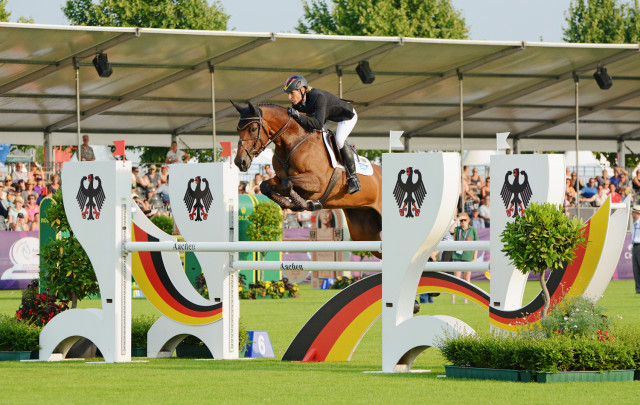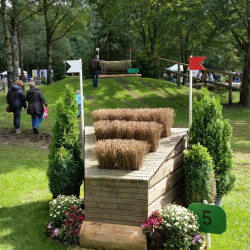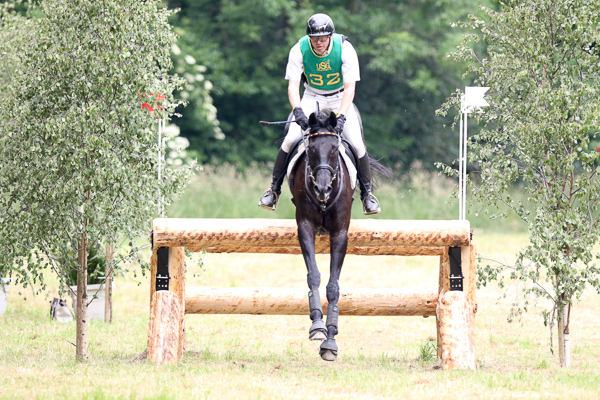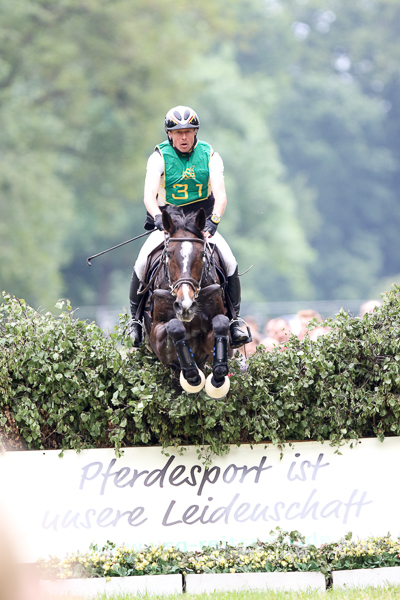Maren Engelhardt attended this year's Bundeschampionat, the official National Championship of the German breed associations, with eight visitors from North America. She's very kindly written a detailed synopsis of the trip, and today we hear about the American impressions of BuCha. Many thanks to Maren for writing and to Stephan Bischoff for providing beautiful photos.
What did the American visitors think of their trip to Bundeschampionat, better know as BuCha? I first asked Tim Holekamp a few questions since he was in the unique position to be an owner at this event (and trust me, the number of American-owned horses running in Warendorf can probably be counted on two hands!).
Maren: What did you think about this idea to listen to immediate translations of judges’ comments in both dressage and eventing?
Tim: “I wasn’t sure how it would work with a large group of strangers, but we did it this time with a dozen of us. I would have to say it was just remarkable. Discussions were open and frank. No one seemed shy about stating opinions or asking questions that were useful to all of us. The camaraderie that developed seemed almost too good to be true, but it was quite real.
“Thanks to Joe Dimmek, we had great audio equipment, and the DOKR gave us a complete tour of their facility, far beyond what an individual could privately arrange there. In summary, we could not be more happy and proud of what came from our little efforts.”
Maren: Are you heartbroken about the low scores your 6-year-old German-based stallion Glücksruf I received for his efforts there in eventing? (Glücksruf scored 6.9 and 6.8).
Tim: “Well, yes and no. I am a competitive sort of person. I do this to win, not to lose, nor even to be an also-ran. We knew that Glücksruf was significantly behind in his training for age, but when he scored a 9.0 at Hanover a month ago on a cross country test, we thought it just possible that he would be successful at the BuCha. I personally was VERY proud of his performances, and understand what knocked down his scores (rideability, which he excelled at in his stallion testings).
“Yet he galloped well, jumped every jump with ease, and has definitely improved his jumping style as he comes to more challenging jumps. The 6-year-old courses contained some two-star questions, in my opinion. He handled them quite well, except in a couple of situations, and even there, got the job done for sure. I still believe in his talent and so does Miriam Bray, his rider.
Maren: How does what you saw at the BuCha relate to the USEA’s Young Event Horse program that you help lead?
Tim: “The main effect is to re-convince me that we are on the right track in this country, but need to improve our training of young horses and selection process of special talents among event horse prospects. The horses that come to the BuCha represent the pinnacle of a couple of thousand horses, so they are not at all the “average” 5- and 6-year-old eventers. To see what those top horses are capable of at age 5 and 6 is truly an eye-opener and resets my “eye” with regard to what we are seeking here.
“I think we have much to gain from the Germans, who are VERY generous in sharing their knowledge with us. This is one of the things I most love about our sport, an open and sharing attitude that appears to be worldwide. Of all the horse cultures I have observed, this is the best one for sure.
I next spoke to first-time visitors and event horse aficionados Matt Boyd and Ashley Giles of Peregrine Farm in Georgia. They also took a good number of the images of the course for the first part in this series.
Maren: How did you spend your days in Warendorf?
Ashley: “I was there not as a judge but as an enthusiast, competitor and breeder in the sport. I watched all of the horses competing in the finals in all three phases because I really wanted to be able to compare the quality of horses at this age with what we have in the States. I of course have not seen all of the horses in this age group in the United States, so I had to pull from what I have seen.”
Maren: How do you think the two groups (US vs. Germany) compare?
Ashley: “The adjustability of the horses in these phases really stood out to me. It seemed to me that the horses that placed the best in the show jumping and cross country were good jumpers, but mostly they were very adjustable and ridable. They were able to move forward to the jumps when they needed to as well as adjust back when they needed to and do so without a lot of fuss and pulling.
“The cross country portion was especially eye opening because they were really asking these horses to gallop and to be able to jump out of that gallop. While not all of them did so successfully, a lot of them did so very well. The courses where very challenging. The technical questions definitely asked a lot of the horses, but the distances where set on a forward, confidence-boosting stride.”
Maren: What was your impression about the sport and its support in Germany now that you have toured the DOKR?
Matt: “Horse sports in Germany are a big deal (duh). There is an entire state-sponsored network of support dedicated to identifying talent (equine and human) and giving their top riders the tools to succeed. This includes things one might not initially consider, such as access to sports psychologists — resources devoted to improving the human side of the equation.
“Young horses are moved faster in Germany than in North America. I suspect this leads to some young horses being over-faced at times, but the sheer number of sport horses bred in the country makes attrition less of an issue, and the event and its qualification requirements tends to identify horses that are not only physically superior, but also have the mental attributes (toughness, resilience, etc.) to succeed at the upper levels.
“Virtually all of the horses were well-produced. Based upon the qualifying requirements, by the time they reach the championship there is not a bad one in the bunch. The level of overall training (not just by certain top-level riders) really stood out.”
Maren: In your opinion, what is the biggest difference in the competition comparing the two countries?
Matt: “The big difference between what we typically see in the U.S. was in the cross country phase. The horses are expected to go at 550 meters per minute and are penalized heavily if they do not make the time. The course is short — about three to four minutes — with about 23 fences (some with A, B, C and D elements).
“The horses make a twisting loop back and forth around a smallish cross country field — you can pretty much see everything. The 6-year-old cross country course had fences that would not have been out of place on a three-star course. The brush fences were particularly large, but none of the horses had too much trouble with them.”
Maren: You are an avid breeder and strive to produce upper-level event horses. Did you notice anything particular about the breeding of the German horses at this event?
Matt: “As for breeding, you had all types. I have not done any deep analysis, but many were crosses between jumper warmblood sires and half-Thoroughbred dams. There were multiple registries in the finals — Oldenburgers, Trakehners, Holsteiners, Hanoverians, Mecklenburgers, South German registries, etc. Only one was more than 75% Thoroughbred (Butts Azahar).
“I’ve been told by people who know that success in the Bundeschampionate does not directly relate to upper-level eventing success — the current Burghley champion did not fare particularly well here (but, on the other hand, horses like Windfall, Butts Avedon, and fischerRocana FST won it).
“With a short cross country course and big fences, a jumper-bred warmblood that is in reality too heavy to progress to a four-star can score really well. That said, there were a number of horses that would be viewed as among the very best of event prospects if they were in this country.”
FEH/YEH and USEF “R” eventing judge Lori Hoos was also along for the ride and shared some of her observations with me.
Maren: What impressed you the most about BuCha?
Lori: “The quality of both the horses and riders; the Pony Championships, which developed the new riders’ skills at such a young age; and the time and respect that was given to the group by officials and friends. I left inspired by what I saw and now have new ideas on how to raise the bar for our country.”
Sharon Burt had joined us from Orlando and was particularly interested in the dressage part of the BuCha.
Maren: What was your impression of BuCha having already been to so many events, stallion stations, approvals and more over the course of many years?
Sharon: “I think the main thing that struck me about BuCha was the depth of quality of the horses and ponies. Every one well conformed, with high expectations of training and behavior, some better than others but overall quality high,” Sharon said. “I enjoyed seeing all three disciplines in one venue, and it was good to see established criteria for all three and a reasonably clear career/training path expected for horses of that quality.”
I next spoke to Donna Richards, a rider from the U.S. along for the trip by pure (lucky) coincidence.
Maren: “What were your thoughts of the dressage judging, which you were especially interested in?
Donna: “There was this one situation that I keep coming back to in my mind. We were listening to your translation of Christoph Hess’ commentary. He has an amazing ability to critique and correct in a positive manner. I recall the first horse that came out entered the arena like a Hollywood movie star and was just outstanding. Unfortunately, the next horse came out having a very bad day, missed most of his lead changes and generally appeared confused.
“I would have likely left the arena in tears, not even wanting to hear what Christoph said. But he was sympathetic to her bad day and able to commend her on what was good, what could be improved and what was just the result of a horse having a bad day — something we all experience at some point. I feel like the rider left the ring disappointed but not desolate.
“I also love how Christoph addressed the crowd when they didn’t like his comments about a particular horse’s walk. After showing their disagreement, he asked the crowd, ‘Did any of you see a collected walk? … No, I didn’t think so.’ He was correct, and I loved the admonishment!”
Maren: You were able to go on a cross country course walk with the course designer, Rüdiger Schwarz. What were your thoughts?
Donna: “The difficulties in designing six different courses on what I consider a very small area were many in my mind. But I actually ended up liking his courses better than any I’ve seen before. Viewing was exceptional and easily accessible for the spectators, which to me is a problem with most courses.
“But truly, the best part of his courses was understanding the care and thought he put into horse and rider safety, questions for the horse and rider that were fair and difficult, and allowing the horse to show his gaits, all while adhering to what the spirit of cross country is about.”
Maren: Any famous last words?
Donna: “From meeting the retired Olympic riders and judges to talking to the guy that helped me park at the event, from visiting the Olympic training facility to visiting the shops on the grounds, from seeing the turbines in the fields to the most beautiful horses anywhere, it was awesome,” Donna said.
Last but not least, I had some questions for Cheryl Holekamp, who set the whole trip in motion a year ago. Cheryl is not only an accomplished Grand Prix dressage rider but is also a USEF “R” judge for dressage and eventing.
Maren: You have raised and produced many outstanding youngsters, especially for the YEH program. What is your overall impression when you compare the two events?
Cheryl: “Attending the BuCha these last two years has broadened my perspective about the path of training in both dressage and eventing. Having bred and produced youngsters in the U.S. for young horse competitions in both disciplines, I can’t help but be impressed with the high expectations and the level of training of the BuCha participants.
“Of course, the horses that appear at the BuCha are undoubtedly the cream of the crop, the most physically and mentally talented, having made it through the rigorous qualifying process. However, the high expectations of the German young horses, especially the young event horses, would be said to be inappropriate/too difficult/overfacing by many in the U.S. For many horses that is probably true in both eventing and dressage.
“Yet, interestingly, all the horses we saw appeared to measure up to the expectation and were not over-faced by the questions. Many parts of the puzzle must come together to produce a young horse to qualify for the BuCha, physical and mental ability of the young horse and the rider and the training program being the most important.”
You can watch videos of this year’s BuCha finalists on the German Champions YouTube Channel. Click here if you missed the first part of this series on an introduction to BuCha and here to read the second part in the series about this year’s winning horses.



















































































